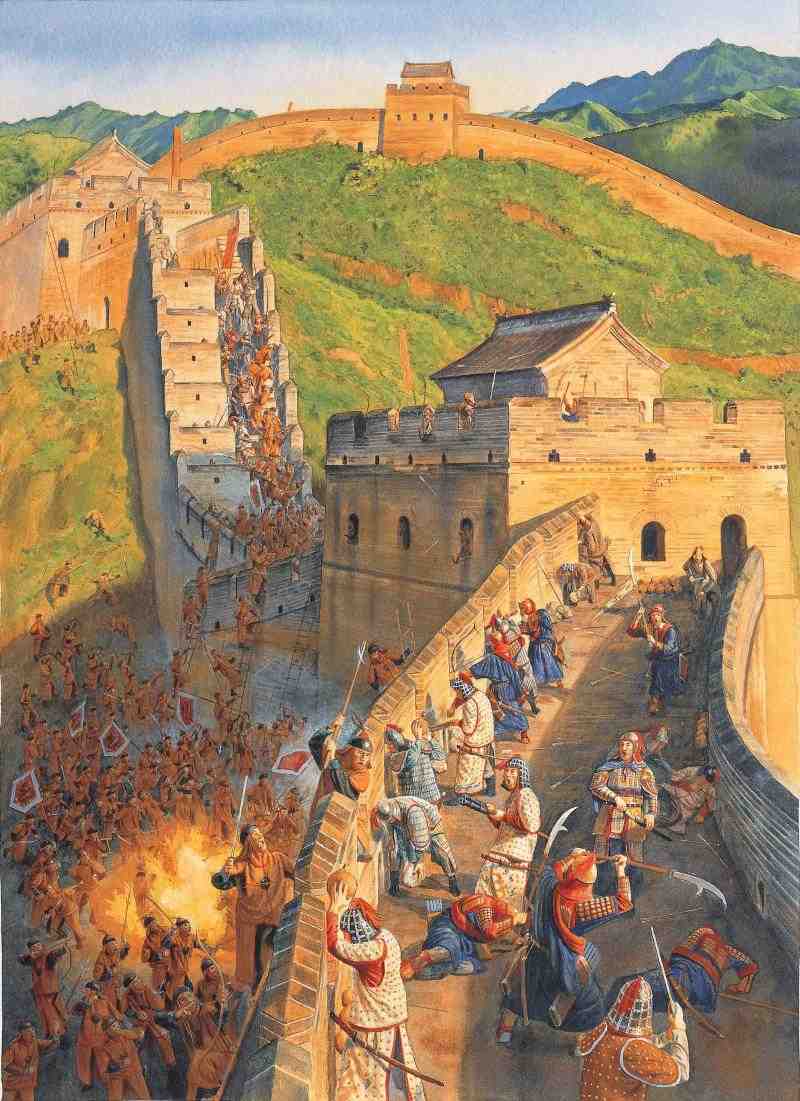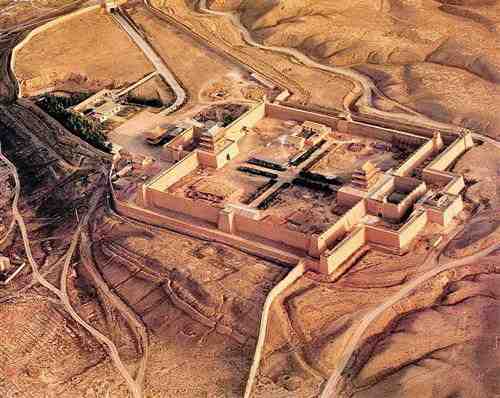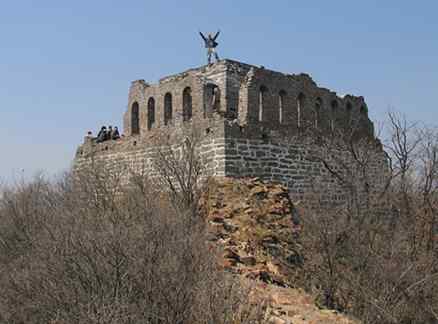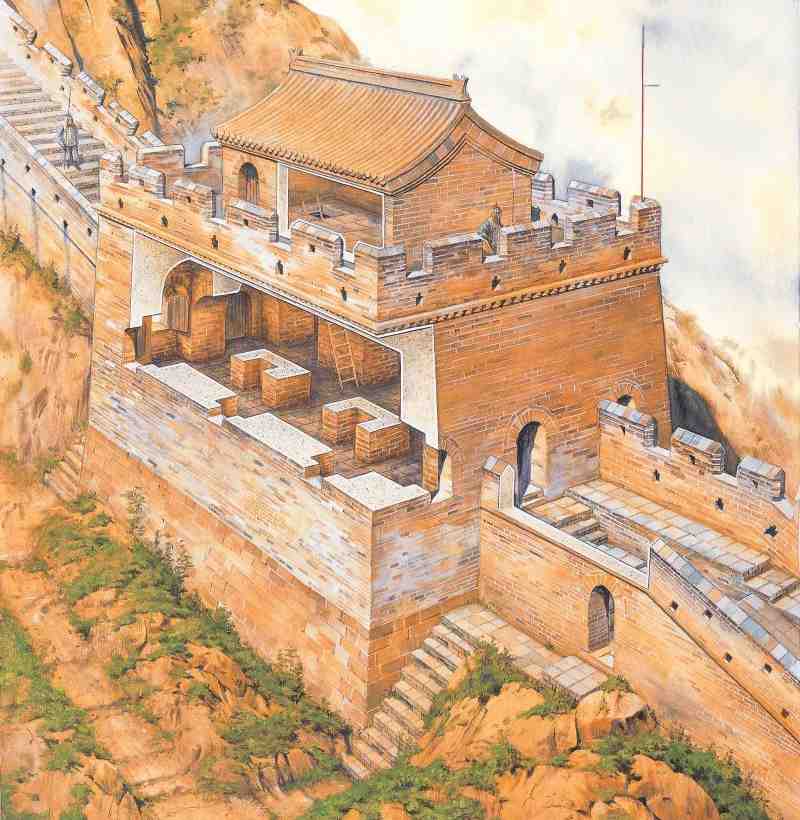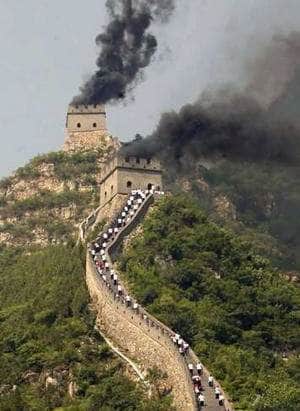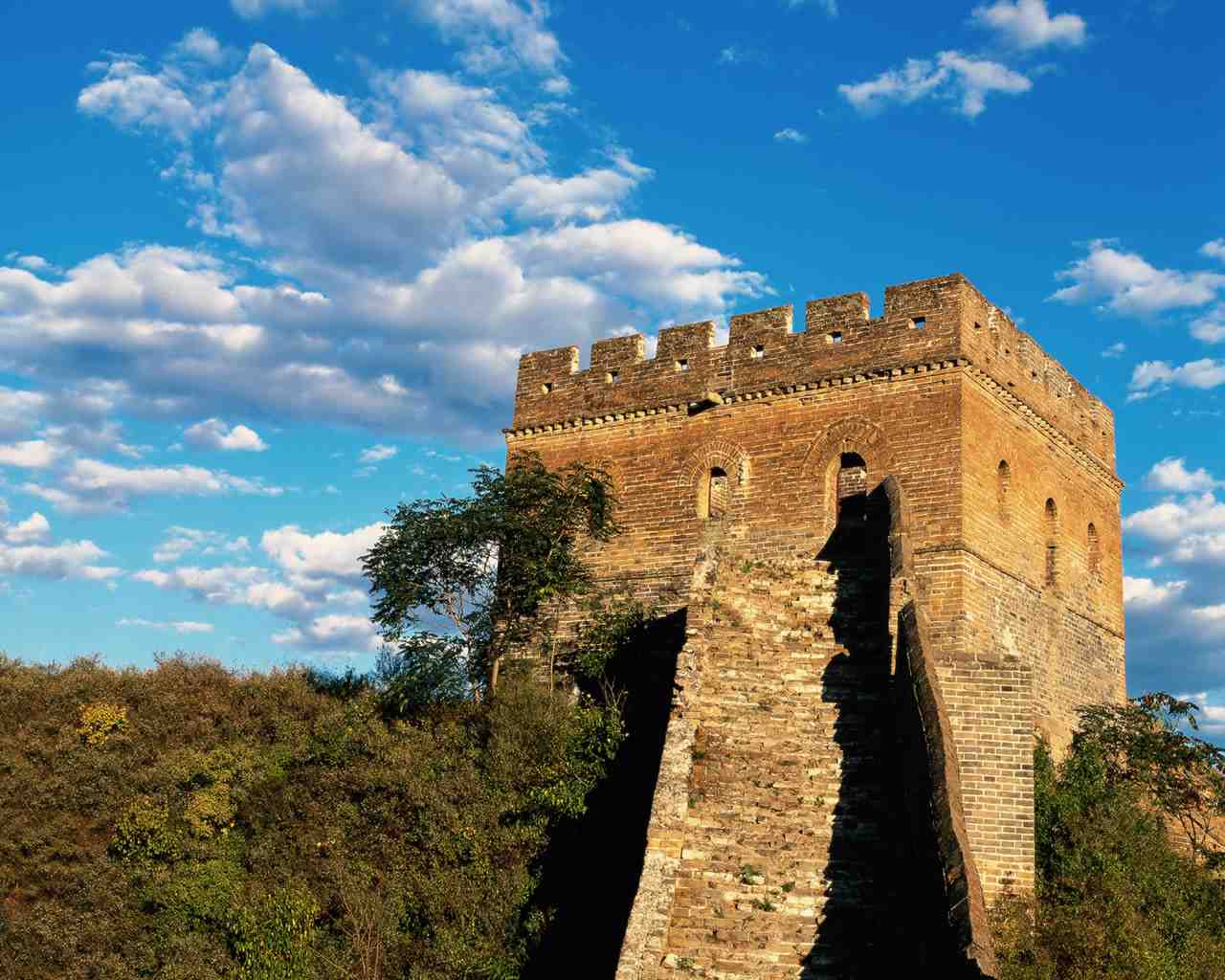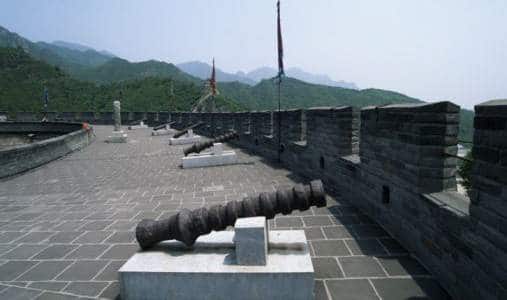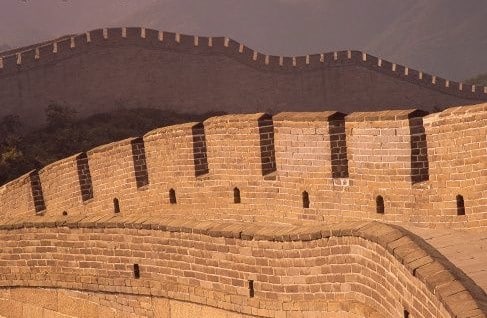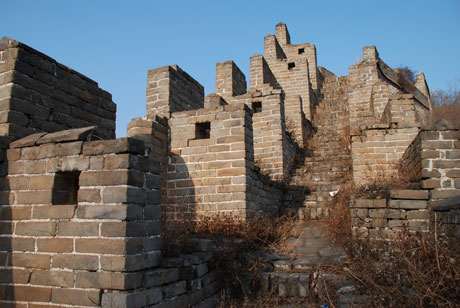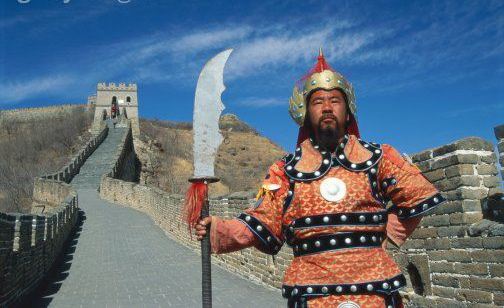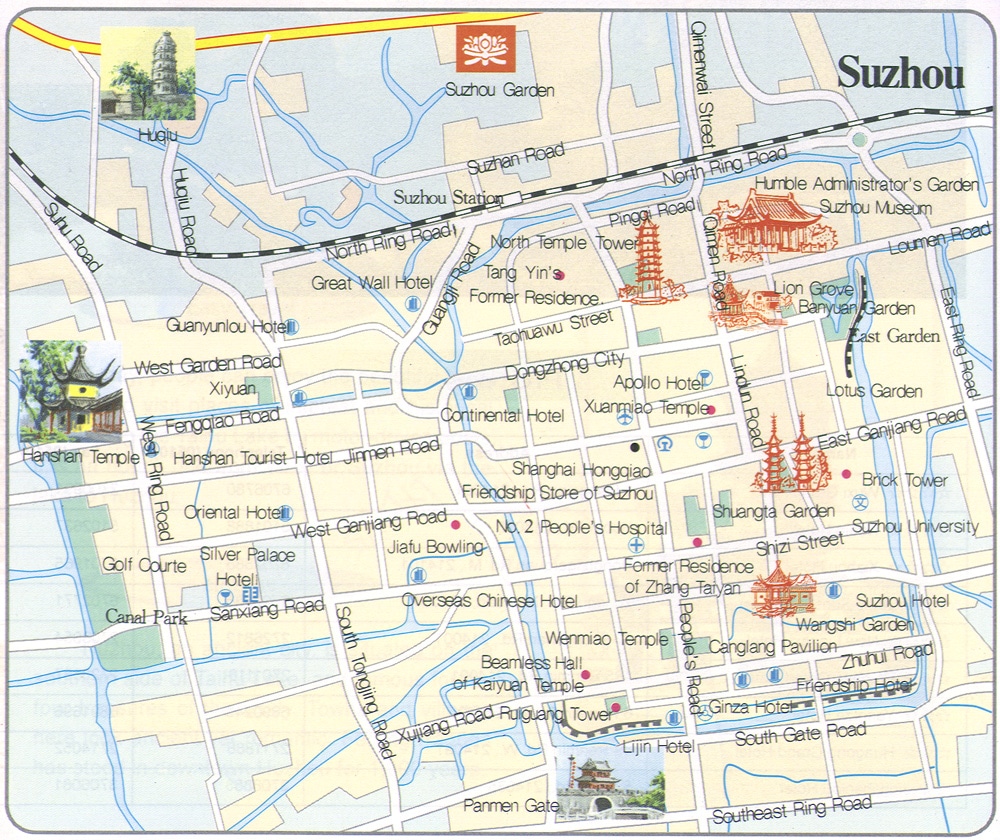Describing a more strategic approach to defending the Chinese empire against their northern neighbors, a Song Dynasty historian wrote:
“Our Chinese infantrymen are at their best in obstructing strategic passes, while the barbarian cavalrymen are at their best on the flatlands. Let us resolutely stand on guard (at the strategic passes) and not dash off in pursuit of them or strive to chase them off. If they come, we should close strategic passes so that they cannot enter; if they withdraw, we should close strategic passes so that they cannot return.”
A COMPREHENSIVE DEFENSIVE SYSTEM
The Great Wall was a remarkably comprehensive defensive system that consisted of the wall itself as well as castle-fortresses, watchtowers, beacon towers, walled compartments, and garrison towns.
Under the Ming Dynasty (1368-1644), the entire system operated under an elaborate chain of command and control. They set up nine military districts—Liaodong, Ji, Xuanfu, Datong, Shanxi, Yulin, Ningxia, Guyuan, and Gansu— each to administer the defense and upkeep of the over 4,100 mile (6,700km) Ming Wall that stretched from the Yalu River in the east to the Jiayuguan Pass to the west.
CASTLE-FORTRESSES
Built along important strategic passes along the Wall’s defensive line, Ming-era castle-fortresses were large military strongholds. They were built on terrain that was easy to defend—typically on high mountains, in deep valleys, or at key locations along a river or gulf.
The idea was that a relatively small force could deter an assault by a much larger invading force. This strategy was echoed in the saying: “One warrior manning the fort denies entry to an army of 10,000” (obviously hyperbole, but you get the idea).
The Ming Wall had close to a thousand of these castle-fortresses (of varying size and scope). A simple pass would only have two walls, each with a gate. A more elaborate one would have a number of maze-like walls along with a series of fortified towers to protect one another.
The largest and most famous ones are the passes at Shanhaiguan, Huangyaguan, Juyongguan, and Jiayuguan. Dating way back to the Han Dynasty (206BC- 220AD) are the fortresses at Yangguan and Yumenguan.
In some of the larger ones, the Ming set up several lines of defense in case the Wall was breached. For instance, the castle-fortress at the Juyongguan Pass was defended by the Beikou, Nankou, and Shangguan gates. The most important outpost of Juyongguan was the Beikou (north gate), which is also known as the famous Badaling.
Wedged between towering peaks, Juyongguan was the largest and most elaborate—not surprising since it guarded the northern entrance to Beijing. It went through a complete restoration in 1992, along with the adjacent Yun Tai (Cloud Platform) bas-reliefs.
ALL ALONG THE WATCHTOWER
The Ming watchtowers were critical components of the Great Wall—used primarily for observation and signaling. Built about 200 yards apart, the more elaborate watchtowers stood over 40 feet tall.
Soldiers would watch for any enemy movements on the top; the bottom was used to store supplies and equipment, as well as used as living quarters.
One of the most impressive of these Ming towers was the so-called Nine-Eyed Tower at Jiankou (pictured right)–located at the border of Yanqing County and Huairou County near Beijing.
BEACON TOWERS: SIGNALING AND INTELLIGENCE GATHERING
Like the watchtowers, the Ming also constructed beacon towers along the Wall (built on higher elevations and spaced about 2.5 to 5 kilometers apart).
This beacon tower system was used as a sophisticated communications system to relay messages and updates about enemy movements all the way to leaders in Beijing. Each tower had a storage of firewood, hay, and sulphur for making fires.
Because dried wolf dung was also used when available, the beacon towers were also known as “wolves’ dung smoke towers”. Back-up methods of signaling were also devised using flags and red lanterns hoisted on long poles.
Ming records reveal instructions on the proper signaling codes:
“The frontier troops are hereby ordered to set beacon fires. If one or two or up to 100 enemies are found, light one beacon fire and fire one salvo. If the enemy numbers 500, light two beacon fires and fire two salvos. Three beacon fires and three salvos indicate more than 1,000 enemy forces. Four fires and four salves are for upward of 5,000 troops. Five fires and five salvos correspond to more than 10,000 enemies.”
Intelligence gathering was also an important function for soldiers stationed on these towers. Mounted patrols, or even the more dangerous deep cover operations, were used to spy on new Mongol developments. In 1449, some agents even penetrated Mongol camps and carried out assassinations. In 1450, a patrol set fire to a Mongol camp before fleeing (taking a trick from the Mongol playbook).
WEAPONS AND BATTLEMENTS
Naturally, the weapons used to defend the Wall evolved over time—from bows (mainly the crossbow, which was invented in China as early as the 4th century BC), spears, and swords to later, guns and cannons. Stacks of stones were also available to soldiers to throw down to advancing enemies.
DEFENSIVE CONSTRUCTION
Battlements were constructed from which soldiers could defend the wall. Naturally, the crenellations (and holes for firing) were only facing the enemy side (although in some rare places, such as at Mutianyu, they can be found on both sides).
Similarly, visitors can also note that all of the drainage holes only drain from the inside of the wall (the “friendly” side). This was to prevent vegetation growth on the enemy side, which could provide cover.
Found in some parts of the Ming-era walls, the zhang qiang (traverse walls) provided a series of defensive barriers if the enemy was able to gain access on top of the wall. Towers also had retractable rope ladders connecting the upper and lower sections so soldiers could fight from above while waiting for reinforcements.
GUARDING THE GREAT WALL
As a strategic defensive system, the Great Wall was certainly a formidable obstacle. But more than just bricks and mortar, the success of it relied on the soldiers who guarded it.
At its peak, the Ming Wall was defended along its length by at least a million soldiers, most of whom lived in structures on the Wall itself. The regional commanders lived in the main garrison towns nearby.
Many imagine soldiers staring off the distance all day looking for enemy movements. But since one of the operational goals was to ensure that all garrisons could be self-sufficient on food supplies through local settlements, less than a third of a soldier’s time was spent on actual military duties. Instead, most of his time was spent working the nearby fields.
Achieving food self-sufficiency, however, was another matter, especially during the winter. For instance, in 1453, there were reports of many observation crews who deserted their posts because of lack of food.


